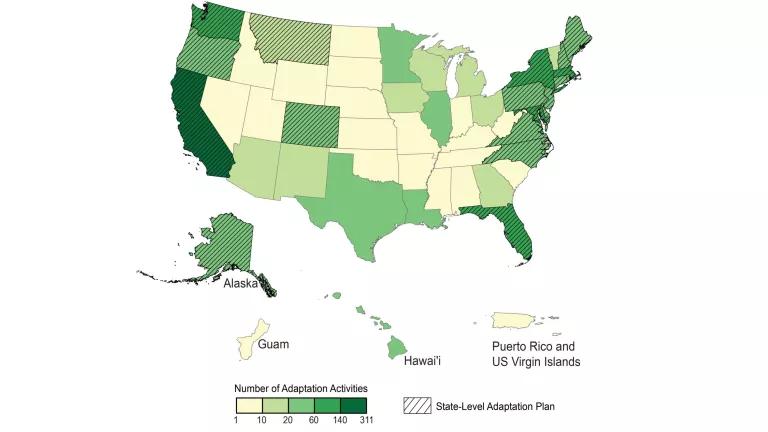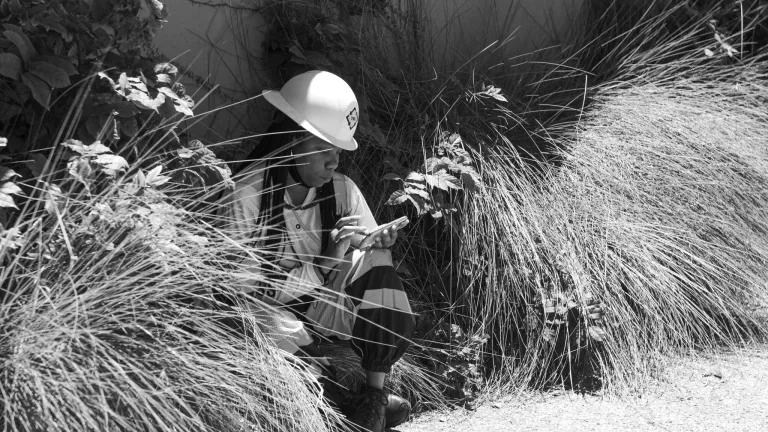The State of the Union Is Hot, Stormy, and Unprepared
The Fifth National Climate Assessment warns that despite recent progress on mitigation and adaptation, the United States is unprepared for the climate crisis.

The number of public- and private-sector adaptation activities publicly documented and/or updated in the United States since 2018.
Figure 31.1, Fifth National Climate Assessment
I’ve read dozens of harrowing stories about extreme heat this year, but there’s one I just can’t shake. Ramona and Monway Ison, who were in their 70s, died along with their dog Belle from heat-related causes the very night they were approved for a loan to fix their broken air conditioner. The A/C in their mobile home had been out for days during a brutal heat wave. But due to limited income, mobility issues, and a belief that they were used to the Texas heat, the couple stayed put—and perished as a result.
Heat waves and other climate-fueled extremes are coming for us all, but they’re coming faster and harder for people with intersecting vulnerabilities like the Isons. That’s one of the main messages from the Fifth National Climate Assessment, released today by the Biden-Harris administration. The congressionally mandated assessment of the current and future risks of climate change finds that the climate crisis is already increasing the number of deaths, injuries, and illnesses in every region of the United States. Systematic racism, discrimination, and disinvestment are exacerbating these harms, particularly in low-income households, communities of color, and Indigenous communities.
For example, the report repeatedly invokes the threat of heat to workers—particularly farmworkers, who toil for long hours outdoors for little pay. Anyone who’s spent hours doing yard work or outdoor exercise has an inkling of how rough the heat can be. But regular exposure to high temperatures combined with insufficient access to food, drinking water, indoor cooling, and healthcare is a recipe for tragedy. Even workers who don’t die from heat face lost work hours and high healthcare costs.

A Día de Los Muertos (Day of the Dead) altar honoring North Carolina farmworkers who died from heat and other preventable workplace hazards, 2023.
NRDC
Lest you think farmworkers dying in the heat is a sad problem, but not your problem, think again. As the assessment states, “These effects on farmworker safety and productivity influence the broader economy through reduced agricultural output and higher food prices.”
So, what’s to be done?
One: we need to drastically reduce the pollution from fossil fuels that’s heating our climate up to dangerous levels. Although the United States still has a lot of work to do to meet its national commitments, historic investments through the Infrastructure Investment and Jobs Act of 2021 and the Inflation Reduction Act of 2022 will help move us in the right direction.
Policies that cut climate-changing pollution—known as mitigation—also protect our health by cleaning up the air. In fact, the assessment finds that “The economic value of avoided hospitalizations and premature deaths from mitigation activities is larger than the cost of implementation.”
Two, and just as importantly: we need to reduce the risks of climate impacts that we’re already experiencing today and prepare for additional impacts in the future. This set of actions, known as climate adaptation, is admittedly complex and getting harder the warmer the world gets. Policymakers, funders, and the private sector have also moved far more slowly on adaptation than on mitigation.
But relying solely on mitigation is not an option. Per the assessment, “Even if greenhouse gas emissions fall substantially, the impacts of climate change will continue to intensify over the next decade.” Cutting emissions will help households like the Isons survive the summers of the future, but adaptation is needed to protect people now.
The National Climate Assessment offers multiple adaptation options to protect health, including:
- Making healthcare systems more resilient to climate shocks, such as hurricanes, mass casualty heat waves, or wildfires.
- Enhancing surveillance of climate-related health harms, including infectious diseases and heat-related illnesses. As the old saying goes, you can’t manage what you can’t measure.
- Early warning systems to help people better understand smoke exposure. A warning system would have been particularly useful this summer, when Canadian wildfires created historically smoky conditions in cities like New York and Washington, D.C.
- Heat-related adaptation, including increased access to affordable, energy-efficient cooling and workplace heat protections.
However, none of these options are sufficient on their own. For example, the Isons would probably still be alive today if their A/C was repaired more quickly or if they had spent a few days with a neighbor. But we can’t air condition our way out of the growing threat of extreme heat, and instead need to rethink how entire neighborhoods and cities are laid out. Similarly, occupational heat standards are essential to protect the workers repairing our roads, delivering our packages, and growing our food. But heat standards will only get us so far without tackling the exploitative labor practices that force heat-vulnerable workers to choose their job over their lives.
In other words, adaptation will have to be nothing less than transformational. That will require upending the historic laws, policies, and practices that are putting Americans in harms’ way and keeping them from living their full, productive, joyful potential. And it requires getting started now.




